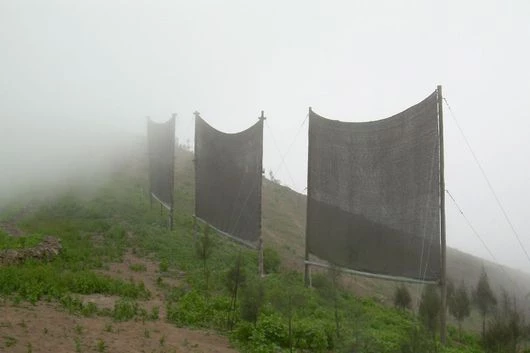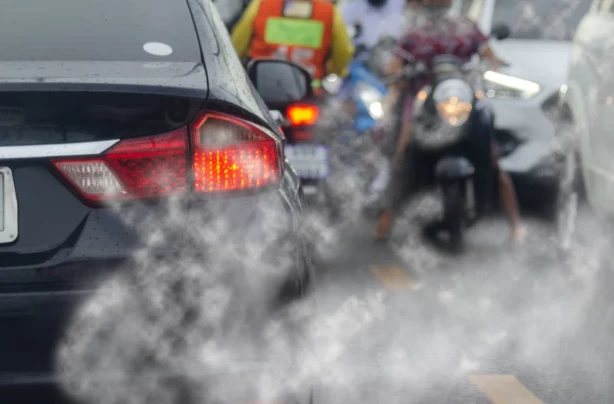What is fog?
, 8 February 2023
The MET Office have issued weather warnings for fog for large parts of the UK today. Fog is dangerous when travelling because it causes poor visibility. Have you walked in a thick fog before? I’ve walked into a fog where I could only see about a foot to either side of me. It was thrilling, but I was on a long, even, mostly empty beach at the time. I wouldn’t have liked to be crossing roads or surrounded by obstacles I couldn’t see.
Fog is made of water droplets smaller than rain drops. Some parts of the world use nets designed to capture the water droplets of fog, which provides a supply of water in areas that don’t see much rain. Some places call this ‘sky fishing’ or ‘stealing from the sky’. How much water do you think can be collected from fog? The MET Office website states that ‘if you were to fill an Olympic sized swimming pool with fog and then somehow condense it, you would be left with around 1.25 litres of water (or just over 2 pints).’
Do you know the difference between mist and fog? It’s visibility! The Met Office states that ‘If you can see more than 1,000 metres it's called mist, but if it is thicker and the visibility drops below 1,000 metres it's called fog.’ Mist and fog are both formed from water droplets collecting in the air, but mist is less dense (meaning an Olympic sized pool full of mist would provide less water when condensed) this means it can be seen through easier and is less likely to stick around for a long time.
Fog can also be described as a cloud forming at ground level. This is because fog and clouds form in the same way. They are the result of warm, moist air being cooled. Water vapour in the air cools to form water droplets. For example, think about how the water vapour from a hot shower, clings to the cool glass of a mirror as condensation. Or, how on a cold day your breath forms a mist when you exhale, as your warm breath mixes with the cold air. Clouds form when warm, moist air meets with cooler air flows. Fog often forms when warm, moist air is cooled by cold surfaces. For this reason, fog is more common in autumn and winter when the ground is coldest. Except for coastal fog, which is more common when warm, moist summer air meets the cold surface of the sea.
Water droplets in fog cause poor visibility by reflecting light, which can distort shapes and make it difficult to judge distances. The MET Office refers to thick fog when visibility is below 180m and dense fog when it’s below 50m (that’s the length of the Olympic sized pool we’ve been talking about!). It’s interesting to note that thicker fogs often form in industrial areas. This is because water droplets cling to tiny particles in the air. At the coast the water usually attaches to salt particles in the air. In industrial areas it’s often particles of air pollution that the water collects around. This means that industrial areas (which are usually the areas of highest air pollution) are more likely to see thicker fogs, because there are more particles in the air for the water to cling to.
Fog that mixes with air pollution is often called smog (smoke fog). Smog can turn the sky green, yellow, red, brown, black or grey. It’s been a problem since the onset of the Industrial Revolution in the late 1700’s, which saw an increase in coal burning for industry (for example to fuel factories and steam trains). In December 1952 London saw what become known as ‘The Great Smog’, during which weather conditions trapped the smoke from coal fires and produced ideal conditions for the formation of a dense fog. Combined, this caused poor air quality that was extremely dangerous. The Clean Air Acts of 1956 and 1968 were a direct result of this, reducing emissions of black smoke. As a result, fewer smogs were reported in the UK in the following decades.
However, since then something known as Photochemical smog (or summer fog) has become more common, especially in largely populated industrial cities with warm climates. This forms when sunlight reacts with pollution particles in the air (nitrogen oxides from car exhausts or coal burning and volatile organic compounds from gasoline, cleaning products and household aerosols). Photochemical smog is bad for our health and damaging to crops and plants. It forms without smoke or fog and is only named the same (smog) because the resulting haze is similar.
So, what can we do? Well, raising awareness by talking to others about what you learn is key. That's why I'm writing this blog and telling you! We can also think about how we can reduce chemicals in the atmosphere. We might choose to walk, cycle or get the bus rather than travel by car. We might choose natural household cleaners and detergents over chemical ones. It can be as simple as choosing a roll-on deodorant over a spray (aerosol) one. By talking about what we learn we can encourage others to sign petitions that raise awareness of issues like air quality and to vote for politicians who show by their voting record that they take issues relating to climate seriously. There are lots of things that can be done, gaining an understanding of the problems and their causes is the first step.
Let’s look at the weather observations sent in by schools this week. I wonder if anyone has mentioned the fog!
School comments:
Stanford in the Vale Primary School: It’s been a windy week and we have finally got to see two digit numbers with the temperatures finally. We can see spring is just around the corner with buds on the trees and snowdrops around the school grounds. We are checking our bulbs every day at the moment.
Livingston Village Primary School: We noticed that all the bulbs have started to grow which are the daffodils. Last year’s daffodils have started growing too.
Irvinestown Primary School: We had snow this week!
Logan Primary School: We have some little green shoots in our plantpots
Sacred Heart Primary School – Omagh: Our bulbs are shooting in both the pots and the ground
St Mary's Primary School (Newry): Still no sight of flowers but the shoots are up for the leaves.
Gavinburn Primary School: After all the rain last week the has been none at all this week and it has felt really cold.
Roseacre Primary Academy: WE can't wait for the flowers.
St Anne's Catholic Primary School – Knowsley: Other days not recorded as ground frozen and path slippery
Fleet Wood Lane Primary School: We are starting to take pictures of the bulbs because we can see the start of the daffodil flowers.




